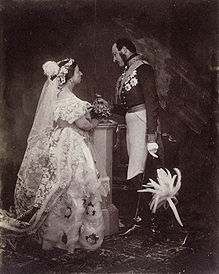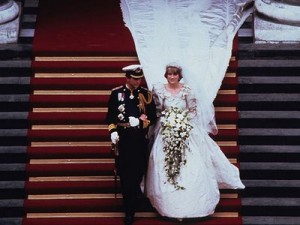From the original white wedding dress worn by Queen Philippa of England in 1406, to all of the white wedding dresses worn around the western world last weekend, our tastes in wedding dress fashion have been directly influence by our royal role models. Queen Philippa did it first, Queen Victoria set the standard, Princess Grace brought sophistication and Princess Diana brought extravagance.
Queen Philippa of England wore white when any colour was acceptable. She wore white silk tunic and a cloak bordered with gray furs when she married Eric of Pomerania, King of Denmark, Sweden and Norway. The colour didn’t become popular until the marriage of Queen Victoria to Prince Albert of Saxe-Coburg in 1840. She chose white simply because she had her hands on some white lace that she wanted incorporated into her wedding dress and chose white silk to match. From that point on, every upper class bride yearned for a white wedding dress.
At this time wedding dresses were custom made, very expensive and only available in up-scale specialty shops. The greater the bounty of fabric a family dressed their bride in for her wedding day, the greater the wealth they were perceived to have. This was expressly conveyed in the length of the train chosen for the wedding dress. The more unnatural the colour of the fabrics they used, or in other words, the farther the colours were from the natural grays and browns of the time, the more exquisite the bride and her family would appear. Purple dyes were do difficult to produce and hard to come by that clothing made with purple fabrics were reserved only for royalty. Red was associated with harlots and therefore was frowned upon for use in wedding dresses. Blue was the colour of purity, as it was said to be worn by the Virgin Mary, and so, was a common choice for wedding dresses. To this day many brides still wear their something blue for this reason, whether they are aware of it or not. White came about merely as a fashion trend and stuck.
Edwardian socialite brides continued the white wedding dress trend, adding more decadence as they went. Wedding dresses were now available in department stores in a more affordable “off the rack” way – thanks to the Industrial Revolution. As with common clothing of the 1920s, wedding dresses too, celebrated the expulsion of the corset with dropped waist silhouettes and loose fitting bodices. This was the first time that hemlines as high as the ankle were acceptable. In the 1930s the corset rebellion fad faded away and women wanted to show their curves again. The waistlines of wedding dresses returned to their natural position and hemlines came closer to the floor. This is the last time where is it commonplace to wear your wedding dress more than once. Brides would remove the special decorations like flowers, ribbons and the train from her wedding dress and wear it again for her rounds of bridal visits, where she visits her friend and family as a newly married woman. Well-to-do women would reuse only portions of their wedding dresses and rework them for use in new dresses. Queen Victoria reused the lace overskirt of her wedding dress in the dress she wore for the 50th anniversary of her coronation. Less wealthy women would dye their white wedding dress a different colour to be worn again. During the 1940s war rationing made white wedding dresses unavailable and unwanted. Some new white wedding dresses were made using recycled silk parachutes. Many women borrowed their wedding dress from a relative who had been married the previous decade or simply wore their military uniform. Often, engagements were short and the bride was pleased to be married in her best dress.
Brides in the 1950s had Princess Grace to look to for fashion inspiration. As casual dress was becoming more relaxed, wedding dress styles were being more and more fancy. Wedding dress fashion has always followed the trends of the time and the 1950s were no different. Wedding dresses at this time were narrow at the shoulders and waist with a full skirt. Many dresses had a tight-fitting, removable lace jacket, as Princess Grace did. Hemlines rose a little higher again and trains were only seen on wedding dresses wore by royalty. White is now the expected rule. During the 1960s wedding dresses had less embellishment than ever. At the mid-point of the decade waistlines dropped again, skirts became less full and trains reappeared. Towards the end of the decade, wedding dresses with empire waistlines became very popular. By the 1970s tight sleeve wedding dresses are out of style. The empire waistline has evolved into the princess waistline and skirts are flared instead of gathered. Pinafore styles are so popular in wedding dresses, that they are often faked, only giving the illusion of a layered look.
In 1981 Princess Diana gave brides the right to go all out on their wedding day. Waistlines returned to their natural position yet again. Fuller, gathered skirts are in vogue again and trains have returned with a vengeance. Sleeves reach critical mass and now come only to the elbow. Wedding dresses have the most embellishment now. Corsets come back in the 1990s, if only in wedding dresses. Off the shoulder styles are also modeled after Victorian evening wear fashions. Waistlines are low, sometimes below the hip, and are often pointed in the front and back. Skirts become less full and have a subtle flare that starts low on the silhouette approaching the end of the decade. Strapless/sleeveless wedding dresses are now seen for the very first time.
Today, what’s old is new in everyday fashion as well as bridal fashion. No matter what decade inspired it, if it’s vintage-looking, it’s in. Every waistline, neckline, hemline, sleeve option, and silhouette is available and the combinations are seemingly infinite. Where is a girl to start?
The best way to find what you want is to go into the bridal store with an open mind. Do your research, and have an idea of what you want, but don’t be afraid to try new things. This way you can find styles that you didn’t even know were available, which you could like more or could even look better on you than the style of dress you had tucked away in the back of your opened mind.
You should wear panties that you wouldn’t be embarrassed to be seen in by a saleswoman who could be assisting you into the dresses and a strapless bra, as you will be trying on many different types of necklines and straps or sleeves. These should be nude or if possible, the underwear you plan to wear on your wedding day. You should do your hair similar to how you think you might want to have it done for your wedding day. It will also help you to pick the dress that makes you look and feel the way you envision yourself marrying the man of your dreams it you wear shoes and accessories similar to those you plan to wear on the day, or the exact pieces, if you have already purchased them.
Some store will allow you to take pictures of the dresses if you bring a digital camera. These pictures can be very useful after you’ve tried on ten dresses and can’t remember how you looked in the first few, not only once you’ve gone home, but also before you’ve even left the store.
Don’t take a large group of people with you when you go wedding dress shopping. The extra opinions will do more to harm than good. Everyone has different tastes and some people will give a false opinion on a dress whether they like it or not for their own self-deluded reasons. I recommend shopping with a group of one to three people comprised of parents, siblings or bridesmaids.
Follow your own fashion sense; don’t be swayed by fads, pushy saleswomen or the fashion sense of friends and relatives. Find something that suits your ceremony and reception locations, type of wedding and time of year. Find something that will light up your fiancé’s face when he sees you walking down the isle to him. Above all else, find something that makes you feel the way you always wanted to feel on your wedding day, whether that be like Queen Philippa, Queen Victoria, Princess Grace, Princess Diana or just yourself.



